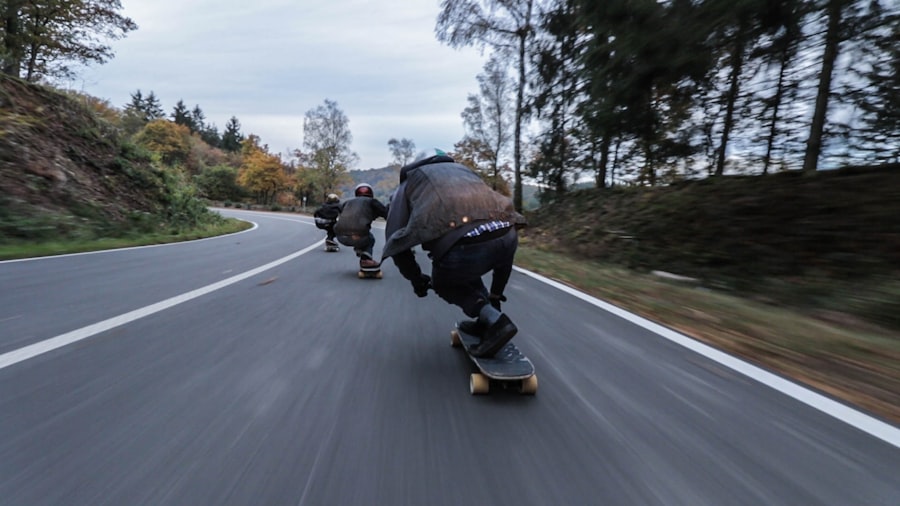Download links
How to install Soaring through the Sky: The Thrill of Wingsuit Flying APK?
1. Tap the downloaded Soaring through the Sky: The Thrill of Wingsuit Flying APK file.
2. Touch install.
3. Follow the steps on the screen.
Description
Wingsuit flying, a breathtaking blend of human ingenuity and the primal urge to soar, has its roots in the early 20th century. The concept of gliding through the air with a suit designed to enhance lift can be traced back to the pioneering work of aviators and inventors who sought to mimic the flight of birds. One of the earliest recorded instances of wingsuit-like designs was in 1912 when French inventor Franz Reichelt attempted to fly using a parachute suit.
His tragic leap from the Eiffel Tower marked a significant moment in the history of human flight, although it was not until the late 20th century that wingsuit flying began to take shape as a recognized sport.
The first functional wingsuits were developed by pioneers like Patrick de Gayardon and Jari Kuosma, who experimented with various designs that incorporated fabric wings between the arms and legs.
These early suits allowed for a controlled descent and horizontal flight, enabling jumpers to glide over vast distances. The sport gained traction in the following years, with advancements in materials and design leading to more sophisticated wingsuits that offered improved aerodynamics and maneuverability.
Key Takeaways
- Wingsuit flying originated from the early experiments of skydivers in the 1930s and has evolved into a popular extreme sport.
- The physics behind wingsuit flight involves the principles of aerodynamics, lift, and drag, allowing wingsuit flyers to achieve forward motion and control their descent.
- Training and safety measures for wingsuit flying are crucial, including extensive skydiving experience, proper equipment, and adherence to safety protocols.
- Famous wingsuit flying locations include the Swiss Alps, the Lauterbrunnen Valley, and the mountains of Norway, offering breathtaking scenery and challenging terrain for experienced flyers.
- The thrill of wingsuit flying is a personal experience that combines the adrenaline rush of freefall with the freedom of flight, creating an unparalleled sense of exhilaration and accomplishment.
- The future of wingsuit flying holds potential for innovations and advancements in equipment, safety technology, and training techniques, as the sport continues to attract enthusiasts and push the boundaries of human flight.
The Physics Behind Wingsuit Flight
The Forces of Freefall
When a wingsuit jumper leaps from an aircraft, they enter a state of freefall, where gravity pulls them downward while air resistance pushes against their body. The wingsuit is designed to create lift by increasing the surface area exposed to the airflow, allowing the jumper to glide horizontally rather than plummeting straight down.
Lift Generation
This lift is generated by the difference in air pressure above and below the wingsuit’s fabric surfaces, which are shaped to optimize airflow. The angle of attack is crucial in wingsuit flying; it refers to the angle between the wingsuit’s surface and the oncoming airflow. A higher angle of attack can increase lift but also risks stalling if it becomes too steep.
Balance and Control
Conversely, a lower angle can lead to reduced lift but allows for greater speed.
Additionally, factors such as body position, weight distribution, and environmental conditions like wind speed and direction play significant roles in determining flight performance.
Training and Safety Measures for Wingsuit Flying

Training for wingsuit flying is a rigorous process that emphasizes safety and skill development. Aspiring wingsuit pilots typically begin their journey with a solid foundation in skydiving, accumulating a minimum number of jumps—often around 100—before they can transition to wingsuit flying. This prerequisite ensures that jumpers are well-versed in freefall dynamics and parachute deployment procedures.
Many training programs also include specialized courses that focus on wingsuit techniques, including body positioning, glide control, and emergency procedures. Safety measures are paramount in wingsuit flying due to the inherent risks associated with the sport. Jumpers are equipped with advanced parachute systems that include automatic activation devices (AADs), which deploy the parachute if the jumper fails to do so at a predetermined altitude.
Additionally, wingsuit pilots often use specialized helmets equipped with cameras for recording their flights, which can also provide valuable insights into their performance and areas for improvement. Pre-jump briefings are standard practice, where pilots discuss flight plans, potential hazards, and emergency protocols to ensure that all participants are on the same page before taking to the skies.
Famous Wingsuit Flying Locations
| Location | Country | Altitude (ft) | Distance (miles) |
|---|---|---|---|
| Chamonix | France | 12,605 | 2.5 |
| Lauterbrunnen | Switzerland | 9,744 | 2.2 |
| Yosemite Valley | USA | 7,214 | 2.8 |
| Rio de Janeiro | Brazil | 2,329 | 1.2 |
Wingsuit flying enthusiasts are drawn to specific locations around the globe that offer breathtaking landscapes and ideal conditions for flight. One of the most iconic spots is Lauterbrunnen Valley in Switzerland, renowned for its stunning cliffs and picturesque scenery. The valley’s vertical drop provides an exhilarating backdrop for wingsuit pilots, who can launch from various points and glide through narrow gorges while enjoying panoramic views of waterfalls and alpine meadows.
Another popular destination is the Troll Wall in Norway, which boasts Europe’s tallest vertical rock face. The sheer height and dramatic landscape make it a mecca for experienced wingsuit flyers seeking adrenaline-pumping descents. The combination of altitude and rugged terrain allows for extended gliding distances, making it an unforgettable experience for those brave enough to take the plunge.
Similarly, the Dolomites in Italy offer a unique blend of soaring peaks and deep valleys, providing ample opportunities for both novice and seasoned wingsuit pilots to explore their limits.
The Thrill of Wingsuit Flying: A Personal Experience
Experiencing wingsuit flying is often described as one of the most exhilarating activities one can undertake. The moment you step out of an aircraft at altitude, there’s an overwhelming rush of adrenaline as you freefall through the sky. The initial seconds are filled with a mix of fear and excitement as gravity takes hold, but once you stabilize your body position and spread your arms wide, you transition into a state of gliding that feels almost surreal.
The sensation of flying—of being suspended in mid-air—creates an unparalleled sense of freedom that is difficult to articulate. As you navigate through the air currents, you become acutely aware of your surroundings—the crispness of the air, the vastness of the landscape below, and even the sound of wind rushing past your ears. Each maneuver requires focus and precision; slight adjustments in body position can dramatically alter your trajectory.
The thrill intensifies as you approach natural features like cliffs or valleys, where you can execute tight turns or swoops that heighten the sense of adventure. For many, this experience transcends mere sport; it becomes a profound connection with nature and an exploration of human limits.
The Future of Wingsuit Flying: Innovations and Advancements

Advancements in Materials Science
Manufacturers are continually exploring lighter yet stronger fabrics that enhance performance while ensuring safety. These advancements could lead to wingsuits that offer improved aerodynamics and greater control during flight, allowing pilots to push their limits even further.
Revolutionizing Performance Monitoring
Advancements in wearable technology are set to revolutionize how wingsuit pilots monitor their performance in real-time. Integrating sensors into suits could provide data on speed, altitude, and even biometric information such as heart rate or oxygen levels during flight. This data could be invaluable for training purposes and safety assessments, enabling pilots to make informed decisions based on their physiological responses while soaring through the skies.
Establishing Standardized Safety Protocols
As interest in wingsuit flying grows globally, there is potential for increased collaboration within the community to establish standardized safety protocols and training programs. This could lead to a more structured approach to wingsuit flying as a sport, fostering greater awareness about safety measures while encouraging new participants to join this thrilling activity.
FAQs
What is wingsuit flying?
Wingsuit flying is a type of skydiving where the participant wears a specialized jumpsuit that adds surface area to the body, enabling a significant increase in lift. This allows the person to glide through the air like a bird.
How does a wingsuit work?
A wingsuit works by creating additional surface area with fabric between the arms and body and between the legs. This increased surface area generates lift, allowing the wearer to glide through the air rather than simply free-falling.
Is wingsuit flying dangerous?
Wingsuit flying is considered an extreme sport and comes with inherent risks. It requires extensive training and experience to safely participate in wingsuit flying. Accidents can occur due to human error, equipment failure, or environmental factors.
What kind of training is required for wingsuit flying?
To participate in wingsuit flying, individuals must first become experienced skydivers. They then undergo specialized wingsuit training, which includes learning about the equipment, body positioning, flight techniques, and emergency procedures.
Where can wingsuit flying be done?
Wingsuit flying can be done in designated skydiving locations and drop zones around the world. These locations typically have the necessary infrastructure and safety measures in place to accommodate wingsuit flying.
What are the different disciplines within wingsuit flying?
There are several disciplines within wingsuit flying, including performance flying, acrobatic flying, proximity flying, and wingsuit BASE jumping. Each discipline requires specific skills and techniques.





